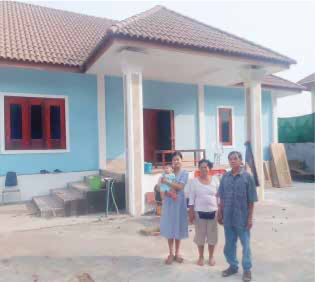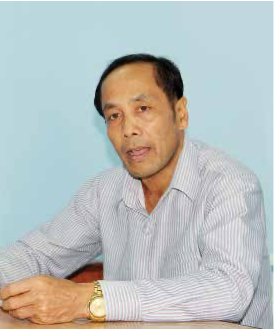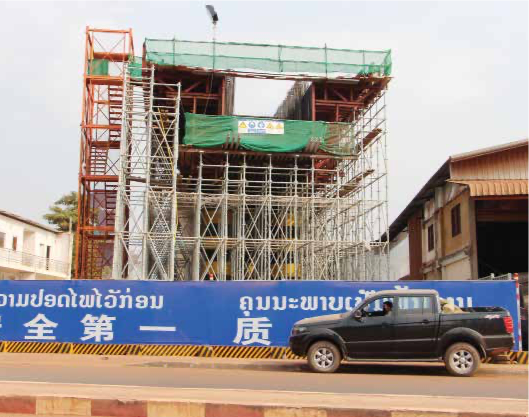

Mr Bounying Luanglath is delighted to have a new home and a plot of land measuring 20 square metres after being awarded compensation for the loss of his former home by the developers of the Laos-China railway.

Mr Bounying Luanglath and his family pose in front of the house they built with the money they were awarded by the railway developer for the loss of their land.
The 60-year-old is one of 85 land owners in Donnoun village, Xaythany district who have received payments from the developer after their land was expropriated to allow for construction of the railway, which terminates on the outskirts of Vientiane.
The 414-km railway is being built from the Chinese border to Vientiane and is part of China's Belt and Road Initiative.
Mr Bounying and his neighbours gave up their homes to make way for the railway. But this sacrifice has not gone unrewarded.
He is now able to open the front door of the blue single-storey house that was built in August last year and welcome his friends, who are all eager to see his new residence.
Mr Bounying's house has a living room, three bedrooms and three bathrooms. "I feel like I have double luck. First, I have a new house. Second, I have a plot of land measuring 20 metres by 20 metres after receiving the compensation payout," he said with a smile.
Before work on the railway began in 2016, he had 1,600 sq m of land. After reading about the compensation to be provided by the developers, Mr Bounying became one of more than 60 people who supported the venture.
The authorities measured his property and found that 780 sq m of land and his single-storey house (measuring 12 m by 20 m) would have to be forfeited so the railway could be built, but he could keep the remaining 820 sq m.
In January 2019, the authorities agreed to pay Mr Bounying a sum of over 800 million kip. Of the more than 60 land owners compensated, he was the first to receive a payout during the first phase of compensation awards.
He used the money to buy 800 sq m of land bordering his property and now has a total of 1,620 sq m.
"I am very happy and satisfied after receiving this compensation," said Mr Bounying. "The money has enabled me to buy 20 sq m of land and a pickup truck. And I have a new house that is the same size as my old home."

Mr Bounvanh Chaksuakao.
The Deputy Governor of Xaythany district, Mr Bounvanh Chaksuakao, said the payment of compensation for a 9.7-km- long stretch of land in the villages of Nongphaya, Nathom, Nongviengkham, Donnoun, Xay and Dongsanghin is almost complete.
There are 360 plots of land covering more than 150 hectares in these villages, for which compensation worth more than 158 billion kip will be paid. More than 142.5 billion kip has already been paid to land owners. The rest of the compensation is currently being disbursed, including for 72 plots of land. The compensation to be awarded for 10 plots is under negotiation.
"We can't pay compensation for some plots of land because we don't know who owns the land and nobody has come forward to claim their rights as land owners," said Mr Bounvanh. To solve this problem, the district is trying to seek out the owners through the media.
Mr Bounvanh, who is a member of a subcommittee of the railway construction project in Xaythany district, says many land owners understand the importance of the project.
A budget has been allocated for the payment of compensation to land owners. The payouts are acceptable and many people want to be part of the effort to develop their community and country.
Laying of the railway track in Xaythany district is expected to be complete in April. "It will be a historic moment for our district when the railway is completed," said Mr Bounvanh. He is optimistic that the railway will create jobs for local people as a station is located in the district.
Goods will be transported more easily thanks to the railway while the district's Nonthong industrial zone will benefit, he said.
He believes better transport links will bring more local and foreign investment to the district, which will support social and economic development including tourism.
Average per capita income in the district was US$3,000 in 2019. The value of foreign investment in Xaythany now exceeds 500 billion kip, most of it in sectors such as livestock, markets, shopping centres and hotels.
"We continue to improve coordination between the district and organizations involved to ensure the compensation is provided quickly," he said. In addition, the district will continue to explain the importance and benefits of the railway for national development to land owners.
Mr Bounying said the compensation provided by the railway developer is better than that provided by some other developers. "I would like everyone to support the railway because our participation will contribute to national development and benefit our children," he said.
The chairman of a task force committee in charge of inspecting the Lao side of the Laos-China railway, Mr Khamsouk Bounnhavong, said recently at the completion of boring and construction of the Boten tunnel in Luang Namtha province that the railway would be finished on schedule.
The railway will boost the Lao government's efforts to turn the nation from landlocked into a land-linked country. Passenger trains can travel at speeds of up to 160km/hour with rail freight at 120km/hour and will link Vientiane to the Chinese border.
Lao and Chinese authorities have agreed to accelerate construction so the railway is complete in time to mark the 46th anniversary of the founding of the Lao People's Democratic Republic on December 2, 2021.
The railway slices through the provinces of Luang Namtha, Oudomxay, Luang Prabang and Vientiane and ends in the capital. It has 75 tunnels with a combined length of 197.83km. The project cost is US$5.986 billion (37.4 billion yuan).
The railway will form part of the planned regional rail route to link China's Yunnan province to Singapore via Laos, Thailand and Malaysia.
The line in Laos will eventually connect with the track in Thailand to form part of the Kunming-Singapore railway, covering a total distance of 3,000 km.
The railway in Laos will result in lower production costs, attracting more traders, investors and tourists and enable Lao products to be competitive on the world market.

Mr Paseuth Lounyadeth
The Head of Donnoun village, Mr Paseuth Lounyadeth, said 85 plots of land in the village in the capital will be expropriated for the railway. The owners of 69 plots have been compensated, and payments are being made to the rest. Most of the people are happy with the amount of compensation offered.
"I think the railway will improve connectivity between districts, provinces and countries. The transportation of goods will be easier than in the past," said Mr Paseuth.

A section of the overhead railway under construction in Donnoun village, Xaythany district.
"I also think the railway supports the government's policy on poverty alleviation in Donnoun village and Xaythany district."